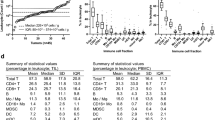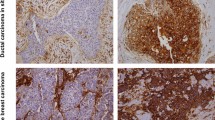Abstract
The reactivity of murine monoclonal antibodies (McAbs) directed against the monomorphic determinants of Class I and Class II antigens of the major histocompatibility complex (MHC), and against antigens expressed by discrete populations of leucocytes was studied using the indirect immunoperoxidase technique on serial tissue sections of 16 benign and 17 malignant primary human breast tumours. Class I antigens (detected by the McAb 2A1) were consistently associated with stromal leucocytes, fibroblasts and vascular endothelium, but expression on epithelial cells particularly of malignant provenance, was more variable. Class II antigens (detected by TDR 31.1) were present upon a variety of cell types which also included sporadic expression on malignant and benign epithelia. The distribution of leucocytes grossly monitored with 2D1 (reactive with a common leucocyte antigen) was largely interepithelial and periductal in benign lesions. Leucocytes were generally more numerous in malignant tumours, where they were largely confined to the stroma. The majority (approximately 75%) of leucocytes were T lymphocytes (reactive with UCHT1), some of which appeared to react with TDR 31.1 and were therefore activated. Ratios of helper/inducer (OKT4+) and suppressor/cytotoxic (OKT8+) subsets generally exceeded unity in malignant neoplasms. There was no correlation between the extent and distribution of T cells and the HLA status of the epithelial cells. Leucocytes detected by the monoclonal antibody OKM1 which reacts with monocytes/macrophages, granulocytes and large granular lymphocytes were numerically few and again mainly confined to the stroma. In a limited number of tests, leucocytes detected with HNKl, reactive with a differentiation antigen expressed on some cells which mediate natural and antibody-dependent cellular cytotoxicity in vitro although detectable interepithelially in benign tumours, were virtually absent from malignant tissue. HNK1 also cross-reacted with myoepithelial cells in the ducts of benign lesions.
This is a preview of subscription content, access via your institution
Access options
Subscribe to this journal
Receive 24 print issues and online access
$259.00 per year
only $10.79 per issue
Buy this article
- Purchase on Springer Link
- Instant access to full article PDF
Prices may be subject to local taxes which are calculated during checkout
Similar content being viewed by others
Rights and permissions
About this article
Cite this article
Whitwell, H., Hughes, H., Moore, M. et al. Expression of major histocompatibility antigens and leucocyte infiltration in benign and malignant human breast disease. Br J Cancer 49, 161–172 (1984). https://doi.org/10.1038/bjc.1984.28
Issue Date:
DOI: https://doi.org/10.1038/bjc.1984.28
This article is cited by
-
Autologous graft-versus-host disease
Medical Oncology (1995)
-
The Immunology of Breast Cancer
Clinical Immunotherapeutics (1995)
-
HLA-D antigen expression and Langerhans' cell infiltrates in thyroid tumors
Endocrine Pathology (1995)
-
Modulation of the antigenic phenotype of human breast carcinoma cells by modifiers of protein kinase C activity and recombinant human interferons
Cancer Immunology Immunotherapy (1992)
-
Study of the relationship between immunohistologically demonstrated lymphocytes infiltrating human breast carcinomas and patients' survival
Journal of Cancer Research and Clinical Oncology (1991)



